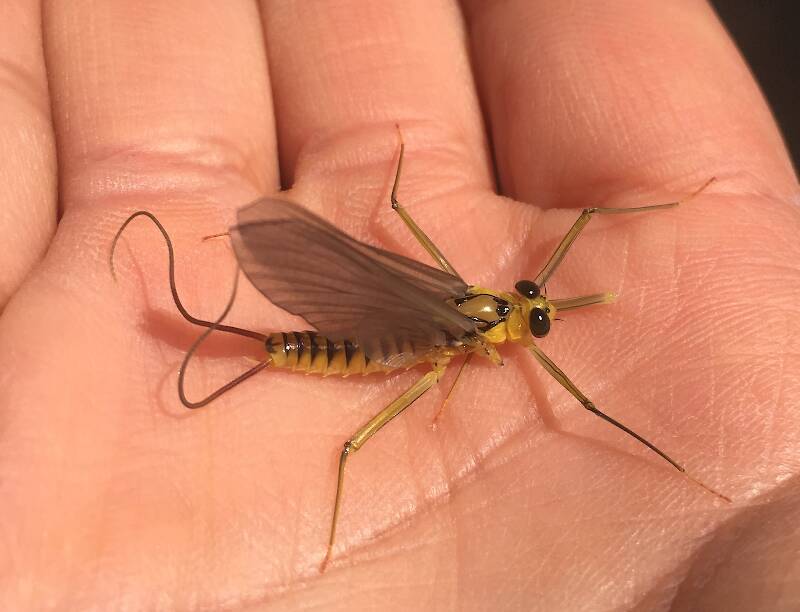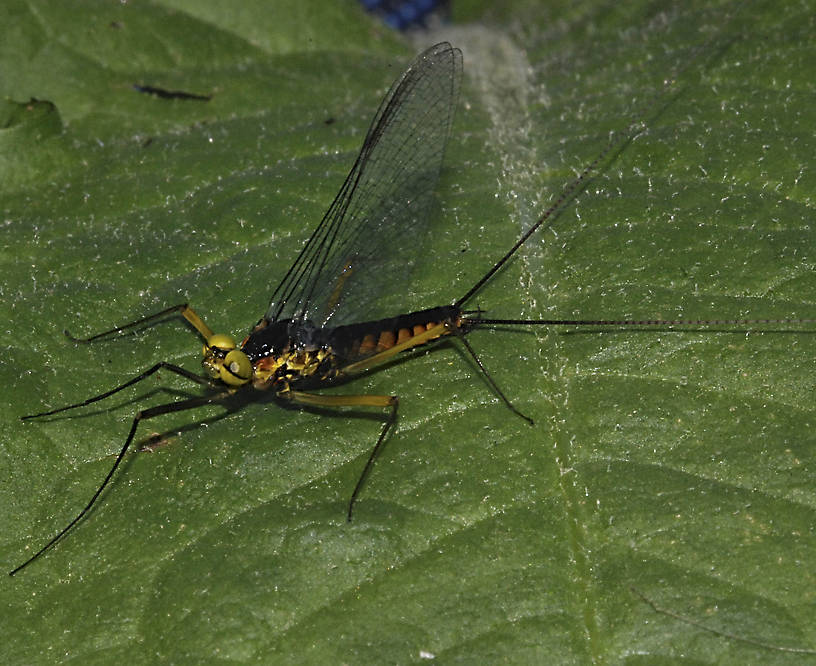
Salmonflies
Pteronarcys californica
The giant Salmonflies of the Western mountains are legendary for their proclivity to elicit consistent dry-fly action and ferocious strikes.
Featured on the forum

Some characteristics from the microscope images for the tentative species id: The postero-lateral projections are found only on segment 9, not segment 8. Based on the key in Jacobus et al. (2014), it appears to key to Neoleptophlebia adoptiva or Neoleptophlebia heteronea, same as this specimen with pretty different abdominal markings. However, distinguishing between those calls for comparing the lengths of the second and third segment of the labial palp, and this one (like the other one) only seems to have two segments. So I'm stuck on them both. It's likely that the fact that they're immature nymphs stymies identification in some important way.

Troutnut is a project started in 2003 by salmonid ecologist Jason "Troutnut" Neuswanger to help anglers and
fly tyers unabashedly embrace the entomological side of the sport. Learn more about Troutnut or
support the project for an enhanced experience here.
Mayfly Species Heptagenia culacantha
This species is not known to be important to anglers. It is noteworthy for its relatively recent discovery, its large size, and the striking coloration of its nymphs and duns. They are sometimes called Tiger Mayflies.
This is the largest species of Heptagenia on the continent, and it's also one of the largest in the entire Heptageniidae family. Nymphs and adult females have been collected with bodies up to a size of 19.5mm, a little over 3/4" long.
This is the largest species of Heptagenia on the continent, and it's also one of the largest in the entire Heptageniidae family. Nymphs and adult females have been collected with bodies up to a size of 19.5mm, a little over 3/4" long.
Where & when
In the paper announcing its discovery, this mayfly was reported only from two very large rivers in New York and Pennsylvania, the Delaware and the Susquehanna. The authors first discovered the nymphs and duns in the Susquehanna near Three Mile Island, PA in 1980, and in 1982 they found more nymphs which they raised into eight spinners. They later figured out that several specimens collected from the Delaware and Susquehanna in 1974 belonged to this new species.This mayfly is very hard to find, even for experts who know where to look. The discovering scientists wrote, "rarely was more than one nymph found on the underside of the same rock." Their attempt to find more specimens in 1981 was unsuccessful. However, the species seems to still be around. The Mayflies of the United States geographic database shows additional records from far northeastern New York and south-central Pennsylvania.
Delaware River fishing guide Paul Weamer of Border Water Outfitters found and photographed a female Heptagenia culacantha dun in 2005, and his photos are posted and discussed in a "name that mayfly" contest on the Fly Fisherman magazine forum. Heptagenia flavescens was incorrectly suggested, but it wasn't far off the mark: Evans (1985) mentions that it is Heptagenia culacantha's closest relative.
Species Range
Nymph biology
Substrate: Underside of large rubble and boulders
Environmental tolerance: Known mainly from a fairly warm trout river and a warmwater river
Specimens of the Mayfly Species Heptagenia culacantha
1 Male Dun

Hyun Kounne generously provided photos of the striking, hard-to-find Heptagenia culacantha from the mainstem Delaware River. She mentioned it was one of maybe half a dozen she saw on the water that day.
1 Male Spinner

This photo was provided by guide Eric Naguski along with the following comments, "I took this photo just upstream of Three Mile Island on the east shore of the Susquehanna River just below where the Swatara Creek enters. The Susquehanna is not an easy river to sample for bugs in my opinion. It is very large and pushes a lot of water. Especially in the spring when you would collect mature culacantha nymphs. And I don't believe that there are a ton of these Heptageniids around. Also the people who are doing most of the sampling like myself are doing so for water quality monitoring work so they only take the specimens down to genus-level taxonomy".
Discussions of Heptagenia culacantha
Added more Heptagenia culacantha info
12 replies
Posted by Troutnut on Dec 19, 2006
Last reply on Feb 8, 2012 by Entoman
I went to the entomology library today and photocopied the 1985 paper that first described this curious species. I've updated the culacantha page with this information.
Link to pictures of H. culacantha
2 replies
Posted by Troutnut on Oct 20, 2006
Last reply on Oct 4, 2007 by Troutnut
Many thanks to user Softhackle for digging up this link. I knew about the thread from back when it started, but I wasn't able to find it when I went back to look last night. Good work!
Fly Fisherman Magazine forum topic with two pictures of a H. culacantha dun.
I've added the species to the "live" part of the database and put up a rudimentary page where I can compile any more information we find.
Fly Fisherman Magazine forum topic with two pictures of a H. culacantha dun.
I've added the species to the "live" part of the database and put up a rudimentary page where I can compile any more information we find.
Does anyone know anything about Heptagenia culacantha?
8 replies
Posted by GONZO on Oct 19, 2006
Last reply on Apr 18, 2007 by Konchu
This is a shot in the dark, but I'm trying to track down descriptive information about a rather rare "mystery mayfly." Heptagenia culacantha was identified in 1985 (Evans, Botts, & Flowers). About all I have right now is a tease from the Journal of the New York Entomological Society--"This infrequently taken species, one of the largest and most striking North American heptageniids, is known only from Pennsylvania and New York."
The reason I'm so interested is that I believe I encounter a fishable hatch of these mayflies every season on one of my favorite PA brook trout headwaters. If that conjures a picture of fishing to 6-7" dinks, you'll need to double those numbers to appreciate how special this stream really is. Add to that an image of the fish rising to these beautiful "mystery mayflies" that hatch in the evening, following a day-long emergence of Dark Green Drakes (Litobrancha recurvata)!
It is such a special event that it is one of the very few things that can pull me away from fishing my favorite Olive Morning Dun hatch (Drunella lata, nee cornuta). Help!
The reason I'm so interested is that I believe I encounter a fishable hatch of these mayflies every season on one of my favorite PA brook trout headwaters. If that conjures a picture of fishing to 6-7" dinks, you'll need to double those numbers to appreciate how special this stream really is. Add to that an image of the fish rising to these beautiful "mystery mayflies" that hatch in the evening, following a day-long emergence of Dark Green Drakes (Litobrancha recurvata)!
It is such a special event that it is one of the very few things that can pull me away from fishing my favorite Olive Morning Dun hatch (Drunella lata, nee cornuta). Help!
Start a Discussion of Heptagenia culacantha
References
- Jacobus, L. M., Wiersema, N.A., and Webb, J.M. 2014. Identification of Far Northern and Western North American Mayfly Larvae (Insecta: Ephemeroptera), North of Mexico; Version 2. Joint Aquatic Science meeting, Portland, OR. Unpublished workshop manual. 1-176.
Mayfly Species Heptagenia culacantha
Species Range
Resources
- NatureServe
- Integrated Taxonomic Information System
- Global Biodiversity Information Facility
- Described by Evans, Botts and Flowers (1985)

